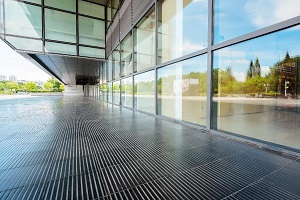- Events
- Conferences Events
- Conferences and Events
- Building Innovations
- Intelligent Buildings
- sustainability initiatives
- Climate Change
- Climate Change
Technology and Buildings – A Solid Foundation for Sustainability

The idea of corporate sustainability risks becoming a business paradox—a symbol of commitments without funding or substance that, in themselves, become unsustainable. However, political uncertainty, understanding of climate risk, and shareholder demands are redefining corporate sustainability strategies. Technology innovation has set the groundwork for a transformation of sustainability strategy, and intelligent buildings are a perfect starting point.
#1: Business Response to Political Uncertainty and Climate Risk Awareness
In early May, a full page ad campaign in The New York Times, The Wall Street Journal, and the New York Post made a call to President Donald Trump to commit to the Paris Agreement. The signatories, 24 companies with a market cap of over $3.2 trillion, proclaimed that US leadership on climate change would strengthen the country’s economic competitiveness, create jobs, and reduce business risks. Uncertainty is bad for business, and a unified approach to study, combat, and adapt to climate change is an imperative for the economy.
#2: Shareholder Demands
Ceres convenes institutional investors for climate change education and advocacy. Climate change risk disclosure is a major focus area, and the group tracks shareholder resolutions that demand portfolio resilience analysis. Ceres cites the resolutions filed at 15 major fossil fuel companies as one line of evidence that shareholders demand climate change preparedness and investment in mitigation. Along the same lines as #1, shareholders see uncertainty as bad for their investments, and with more unity, major investors are demanding action and planning on climate change.
Start with Intelligent Buildings
On May 4, I moderated Energy Efficiency in Buildings – Technology Helping to Set New Benchmarks, a webinar for Realcomm. The roundtable discussion and results of real-time polling support the argument that technology can provide measurable improvements on sustainability and tie to climate change commitments.
A question to the audience highlighted the confusing state of branding and opinions around sustainability. The audience was asked, “Would you rather your company be considered ‘green’ or ‘efficient’ by your customer base?” The results were striking: 80% chose “efficient,” while only 20% chose “green.” This result underscores the challenges companies have faced with sustainability initiatives that failed to rely on technology or reflected measurements in time rather than ongoing improvements.
John Seaton, director at RealFoundations, helped illustrate how technology can deliver bottom-line benefits and change the face of sustainability. In two case studies, RealFoundations identified significant energy and associated cost savings with data analytics in 4-star ($20,000 energy savings) and 5-star ($10,000) NABERS Energy (the Australian equivalent to LEED) scored buildings. This evidence sets the stage for how technology can amplify the benefits of sustainability commitments.
There is power in aligning technology and sustainability. An intelligent building is defined by a data infrastructure for ongoing monitoring and operational changes. Once a commercial building has the IT backbone for capturing detailed data on a continuous basis, there is a platform for systemic change that can deliver sustainability benefits while supporting the bottom line. The dataset is the input and the output is a near endless array of business metrics—utility cost savings, equipment maintenance reports, occupant satisfaction, or carbon emissions reductions. The real benefit is that as a tool for sustainability, an intelligent building delivers quantifiable energy, resource, and traditional sustainability metrics. It also delivers business improvements that keep executive decision makers committed and budgets lined up.